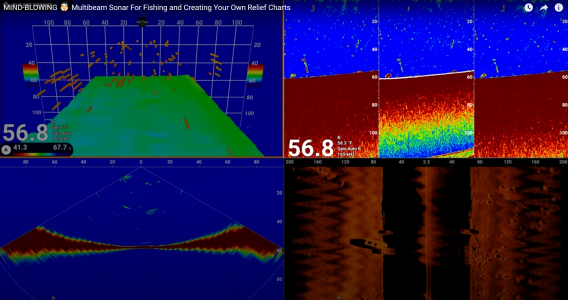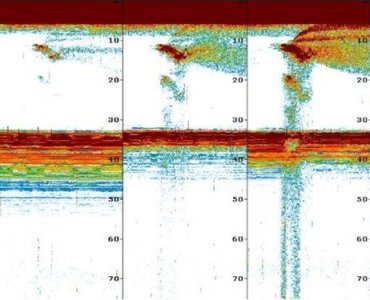Watching the Furuno Making Waves - MIND-BLOWING  Multibeam Sonar For Fishing video, I notice some things bothering me on my TZT3/DFF-3D installation:
Multibeam Sonar For Fishing video, I notice some things bothering me on my TZT3/DFF-3D installation:
a) Look closely at the triple beam screen display in the video -at about 20 minutes, 40 seconds. There is a small bump near the center on the bottom in each of the 3 beams. Something is wrong - there are not 3 perfectly spaced 'bumps' down there. There is only 1 bump and it appears in all three beam displays. Also note the symmetry of the fish echoes in the lower left corner of each beams' display. Again nope - that is NOT what's down there. Yet, my display contains the same errors; everywhere, all the time..
b) Next consider the bottoms in the triple beam image shown in the video. There is a depth gauge for each beam. Across each beam a depth change of about 10' is shown - a roughly 30' depth change across the whole scanned area. I think the images should align at the edges of the beams and the whole of the bottom image should appear as a single continuous bottom view across the 3 beams. The shown bottom contours and depths CAN'T be correct.
I was thinking I'd incorrectly connected my transducer to the DFF-3D and need to review my work. During installation I'd noticed an anomaly between my DFF-3D and the installation instruction, talked to FURUNO customer service about it, and followed their instructions. Perhaps there is an error in the instructions that at least some of us receive, or perhaps a common misunderstanding of the instructions, or perhaps you have a system problem.
nlol
a) Look closely at the triple beam screen display in the video -at about 20 minutes, 40 seconds. There is a small bump near the center on the bottom in each of the 3 beams. Something is wrong - there are not 3 perfectly spaced 'bumps' down there. There is only 1 bump and it appears in all three beam displays. Also note the symmetry of the fish echoes in the lower left corner of each beams' display. Again nope - that is NOT what's down there. Yet, my display contains the same errors; everywhere, all the time..
b) Next consider the bottoms in the triple beam image shown in the video. There is a depth gauge for each beam. Across each beam a depth change of about 10' is shown - a roughly 30' depth change across the whole scanned area. I think the images should align at the edges of the beams and the whole of the bottom image should appear as a single continuous bottom view across the 3 beams. The shown bottom contours and depths CAN'T be correct.
I was thinking I'd incorrectly connected my transducer to the DFF-3D and need to review my work. During installation I'd noticed an anomaly between my DFF-3D and the installation instruction, talked to FURUNO customer service about it, and followed their instructions. Perhaps there is an error in the instructions that at least some of us receive, or perhaps a common misunderstanding of the instructions, or perhaps you have a system problem.
nlol
Last edited:




